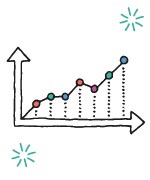L&D Barometer

Measure the business impact and ROI of your L&D
In collaboration with

Do you want to understand the impact your L&D programme is having on your business?
We have worked with the world-renowned ROI Institute to create an easy-to-use calculator, which offers advice on how to create an L&D programme that delivers.
Warwick Conferences’ L&D Barometer is a world-exclusive tool designed with the L&D industry in mind. By answering eight simple questions, you will be able to:
- Extract the key components which impact the success of a programme, following extensive research carried out by ROI Institute.
- Understand the elements of your programme which are performing well.
- Analyse the current impact on your business, enabling you to design the perfect programme.
- Retrieve a tangible ROI for your programme to share with peers and team leaders.
Simply answer our eight questions and start your journey to understanding how your programme makes an impact on your business. Book your free L&D consultation today.
Offsite facilities [factor 1 of 8]
This question is designed to understand the type of facility used when delivering your L&D programme.
 In what format do you intend to deliver your programme?
In what format do you intend to deliver your programme?
- Online course completed during working hours.
- Online learning in a distraction-free environment (e.g. logged out of all work programmes, such as email).
- Blended/Hybrid learning with teacher-led programme.
- An off-site training course.
- An off-site training course led by an expert teacher.
Direct reports [factor 2 of 8]
This question is designed to understand how many direct reports the delegates have. For example, if your delegate is responsible for 10 people, then you would select 6-15.
 Approximately how many direct reports do the delegates of this planned programme have, on average?
Approximately how many direct reports do the delegates of this planned programme have, on average?
- Zero
- 1-5
- 6-15
- 16+
- Direct reports are leaders.
Business alignment [factor 3 of 8]
This question is designed to understand the level to which business impact has been a factor in the design of the programme. This specifically relates to how the programme drives results to the business, e.g. increased sales.
 To what extent is the planned programme connected to business measures?
To what extent is the planned programme connected to business measures?
- There is no presence of a business measure or connection and no KPIs are set.
- The programme is designed to improve an obvious measure. For example, if a programme is focused on compliance, then the business measures are compliance discrepancies that can be prevented. No KPIs are set.
- There is a moderate business connection because some communication has been made to create the understanding that this programme should drive the business forward. KPIs and vague objectives are set, but not consistently reported.
- One or more business measures are identified at the beginning of the programme. KPIs and objectives are set.
- The business measure will be the focus of the programme. KPIs and specific objectives are set, and the programme is adjusted depending on the success towards meeting business goals.
Appropriate solution [factor 4 of 8]
This question is designed to understand if the programme is the most appropriate solution to driving business measures.
 What has been done to ensure that the planned programme is the most appropriate solution to improve the business measures?
What has been done to ensure that the planned programme is the most appropriate solution to improve the business measures?
- Nothing.
- There has been minimal discussions about how this programme can improve the organisation and deliver an impact.
- There are some logical connections between using the content from the programme and the outcome expressed as a business measure.
- There will be significant discussion with delegates, including activities to help them reach the conclusion (before their participation) that this is the right content/skill set that they need.
- There has been ample formal discussion with each delegate which has led them to logically conclude that this is a solution that will influence the business measure.
Focus on success [factor 5 of 8]
This question is designed to understand the process in which you set objectives and KPIs for the programme.
Please note: ‘reaction objectives’ relate to objectives set on the desired reaction from the delegates participating in the training. These objectives will include relevance to the delegates’ job and their intent to use the training
 Have you set objectives for your programme at each outcome level including impact?
Have you set objectives for your programme at each outcome level including impact?
- There are no objectives for the programme.
- Vague learning objectives have been developed.
- Reaction and learning objectives are developed, to focus on the importance of the programme to the participant.
- Specific objectives for reaction, learning, and application levels have been developed.
- Very specific objectives for reaction, learning, application, and impact levels have been developed.
Appropriate audience [factor 6 of 8]
This question is designed to understand the number of delegates that the training is suitable for.
 Will the intended audience for the programme have an opportunity to use the knowledge and skills?
Will the intended audience for the programme have an opportunity to use the knowledge and skills?
- Less than 70% of the delegates in this programme will have the opportunity to use the knowledge and skill from the programme.
- Between 70% and 80% of delegates are in the right roles and will have an opportunity to use the knowledge and skills from the programme.
- Approximately 80% to 90% of delegates are in the right role and will have an opportunity to use the knowledge and skills from the programme.
- Between 90% and 95% of delegates are in the right role and will have an opportunity to use the knowledge and skills from the programme.
- More than 95% of delegates are in the right role and will have an opportunity to use the knowledge and skills from the programme.
Perceived value [factor 7 of 8]
This question is designed to understand how much the delegates perceive the value of their L&D programme.
 Do your delegates perceive the programme as valuable (relevant, important to their success, and with the intent to use the content)?
Do your delegates perceive the programme as valuable (relevant, important to their success, and with the intent to use the content)?
- No.
- At least 30% of delegates will perceive this programme as valuable.
- At least 50% of delegates will perceive this programme as valuable.
- At least 70% of delegates will perceive this programme as valuable.
- At least 90% of delegates will perceive this programme as valuable.
Manager support [factor 8 of 8]
This question is designed to understand how much support managers of participants provide, including how actions following the programme are followed up.
 Does the delegate’s immediate manager support this programme?
Does the delegate’s immediate manager support this programme?
- No.
- There is minimal manager support. There is some expectation that managers understand the programme, but there are no official measures of this.
- There is moderate manager support. Managers of delegates have been informed about the programme and their role in making the programme successful.
- There is a significant amount of manager support. Managers of delegates have been asked to take a more active role in ensuring that delegates are prepared for the programme and the subsequent follow-through.
- There is a very significant amount of manager support. Managers will meet with the delegates before the programme to set goals, and then after the programme to confirm the learning. Then, managers set expectations for use and are available as a coach when necessary.
You're nearly there...
Just submit a few details and you'll have access to your L&D Barometer results.
L&D Barometer results
In collaboration with

Your results
Your ROI is in the range of n%
Allowing for a 22% margin of error, this means your ROI could be between n% and n%.
If the assessments for the eight factors are accurate, there is a 95% confidence that the value will be in this range.
This means that for £1 invested, we estimate that you will gain/lose £n.nn
Your programme based on the estimated ROI
- -26% to -100% Very unsuccessful; Programme needs significant improvement.
- -6% to -25% Unsuccessful; Some elements are present for success: Multiple opportunities for improvement exist.
- -5% to 25% Average success; Still, need more focus on improvement.
- 26% to 100% Above average success; Refine current processes for even more improvement.
- 100% to 200% Excellent programme; Should yield a positive business contribution. There is still potential for more results.
Your ratings
About your results
If your ROI estimation is less than what you desire, seek out opportunities for improvement. As you observe your ratings, consider those rated one, which essentially removes that factor from the analysis (i.e., it did not add to the ROI total). These items present the best opportunity for improvement.
The second-best opportunity is to consider those factors rated two, and the third-best opportunity is to consider the factors rated three, etc.
Examples for improvements would be to take an action that was not planned, involve others, change a process, or design for impact and ROI. After these actions have been planned or implemented, repeat the process to generate a new estimated ROI. If the total is still less than desired, complete another iteration of improvements to see what must be changed to reach your goal.
This cycle can continue until an ideal ROI is estimated. This is the value of using the L&D Barometer —it helps you improve your programmes to ensure they deliver the value that you need.
Get in touch
Want to dicuss your results or make a booking for your next L&D programme?
Simply get in touch and our specialist Business Development Management team will show how we can help you imagine, experience and achieve your goals.
Phone Request a call back
Phone +44 (0)24 7652 3222
Email talktous-conferences at warwick dot ac dot uk

Disclaimer
Warwick Conferences’ L&D Barometer is an online tool developed to support those looking to explore the strength of a programme, learn how to make improvements and understand what areas of a programme have an impact against the ROI. The analysis has been provided by the ROI Institute, based on almost 2,000 pieces of existing research on this subject.
The information provided by the Warwick Conferences’ L&D Barometer is for illustrative purposes only and accuracy is not guaranteed. The values and figures shown are hypothetical and they may not be applicable to your individual situation. These results do not provide a guarantee of any future performances. You should not rely on any past performance as a guarantee of future investment performance or otherwise. You should not rely upon the material or information provided as a basis for making business, legal or any other decisions. We make no representations or warranties of any kind, express or implied about the completeness, accuracy, reliability with regards to these results for any purpose.
